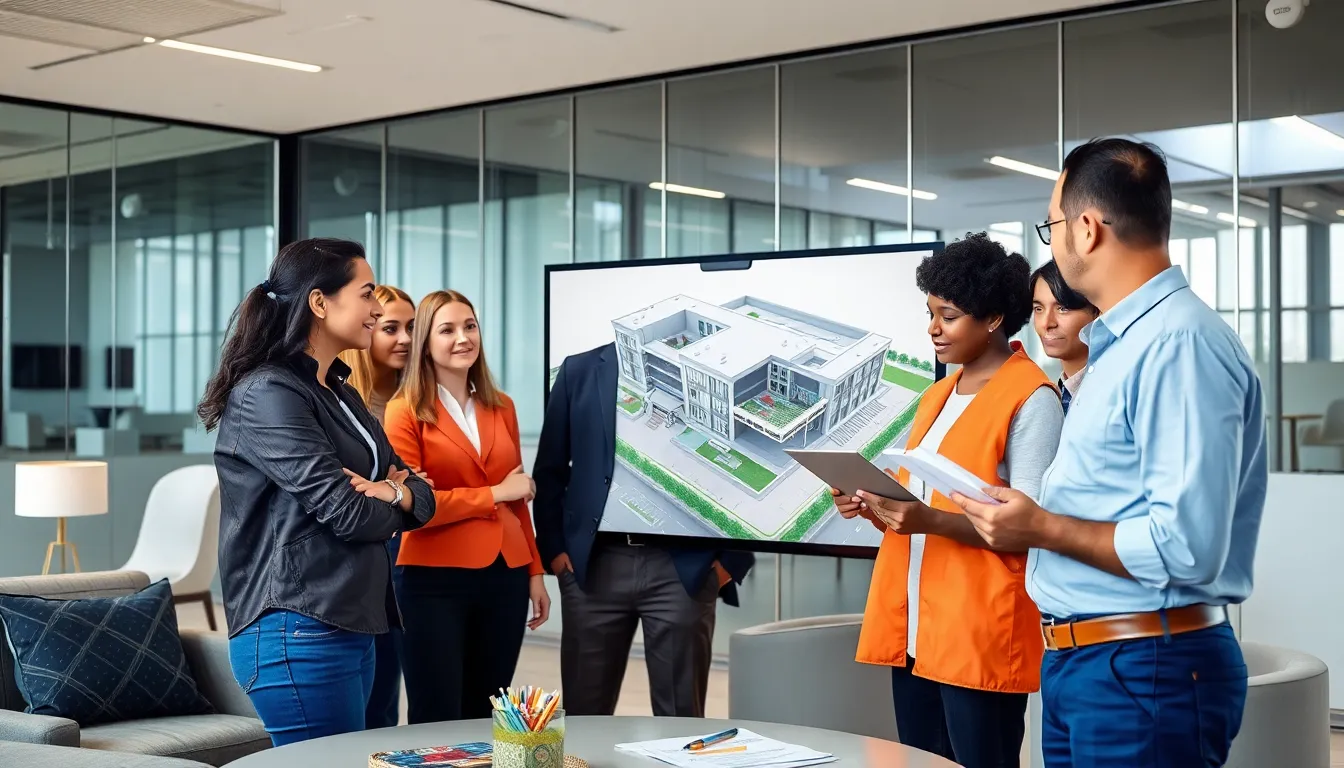In a world where construction projects often resemble a game of Jenga, Building Information Modeling (BIM) swoops in like a superhero with a hard hat. Imagine having a crystal-clear digital representation of a building before a single brick is laid. That’s BIM for you—it’s not just a fancy acronym; it’s the future of construction.
Table of Contents
ToggleOverview of Building Information Modeling
Building Information Modeling (BIM) represents a significant shift in how construction projects are approached. It involves creating and managing digital representations of physical and functional characteristics of places. This process allows all stakeholders, including architects, engineers, and contractors, to collaborate effectively from the initial design phase to project completion.
BIM enhances visualization by providing 3D models that reveal intricate details often missed in traditional 2D plans. Stakeholders access real-time data, streamlining communication while reducing errors. Decisions are based on accurate information, improving project outcomes and minimizing costly revisions.
Cost estimation becomes more precise with BIM, as it includes material quantities and cost data directly linked to the model. This integration allows for better budgeting and resource allocation, resulting in efficient project management. Scheduling benefits as well, where construction timelines can be visualized alongside the model, enabling proactive adjustments.
Data analysis is improved through BIM’s comprehensive approach. Historical data from previous projects informs future designs and decisions, fostering continuous improvement in practices. Risk management sees enhancements due to better foresight into potential conflicts and issues during construction.
Sustainable design practices are easier to implement via BIM, as it allows for simulations of energy use and environmental impact assessments. This focus on sustainability aligns with industry trends towards greener building practices.
In short, BIM’s comprehensive capabilities transform the construction sector. By integrating various aspects of design, execution, and maintenance, it establishes a structured framework for managing projects effectively while promoting collaboration across disciplines.
Key Components of Building Information Modeling

Building Information Modeling involves several key components that enhance project delivery and management.
3D Modeling
3D modeling serves as the foundation of BIM. It creates detailed visual representations of buildings, enabling stakeholders to explore design elements interactively. Architects can manipulate designs in real-time, identifying potential issues early. Engineers benefit from precise spatial relationships, ensuring systems integrate seamlessly. Contractors save time during construction phases by visualizing workflows and materials. Clients gain clarity regarding the project’s outcome, allowing informed decisions. Effective 3D modeling streamlines communication and fosters transparency among all parties involved.
Data Management
Data management is vital in BIM, as it organizes detailed information in a structured manner. BIM integrates various data types, such as material specifications, cost estimates, and schedules. Users can easily access and update data, promoting accuracy throughout the project lifecycle. By linking relevant information directly to the model, stakeholders can analyze metrics effectively. Historical data contributes insights, enhancing planning for future projects. Centralized data storage encourages collaboration and ensures every team member works with the latest information. Robust data management supports better decision-making and reduces costly errors.
Collaboration Tools
Collaboration tools within BIM enhance teamwork among different stakeholders. These tools facilitate real-time communication, allowing architects, engineers, and contractors to share updates instantly. Integrated platforms streamline workflows, reducing delays caused by miscommunication. Cloud-based solutions provide access to project files anytime and anywhere, fostering a cohesive working environment. Moreover, integrations with various software improve compatibility across disciplines. Effective collaboration tools support problem-solving and innovation, ultimately driving project success and efficiency.
Benefits of Building Information Modeling
Building Information Modeling (BIM) offers numerous advantages, fundamentally changing construction project dynamics. This section explores specific benefits that BIM provides to the industry.
Enhanced Visualization
Visual clarity improves significantly with BIM through detailed 3D models. Stakeholders interact with accurate representations of buildings, seeing elements that 2D drawings often miss. This immersion shows spatial relationships, allowing for better understanding of designs. Real-time updates keep everyone informed, ensuring project alignment. Clarity in communication leads to fewer misunderstandings, reducing the likelihood of costly revisions.
Improved Project Coordination
Collaboration flourishes in BIM-enabled environments. Teams of architects, engineers, and contractors can access shared models, leading to synchronized efforts throughout the project lifecycle. This shared platform enables the identification of potential conflicts before construction begins. Coordination becomes seamless, enhancing teamwork and reducing delays. Regular updates and feedback loops ensure all stakeholders remain on the same page, promoting efficiency across all processes.
Cost and Time Efficiency
Cost savings emerge prominently when utilizing BIM. Accurate material estimates reduce waste, leading to smarter purchasing decisions. Time efficiency stems from optimized scheduling and the ability to foresee project milestones clearly. Adjustments to plans occur quickly, minimizing disruptions that often arise with traditional methods. Overall, these efficiencies translate into projects completed on time and within budget, driving substantial economic benefits for stakeholders.
Challenges in Implementing Building Information Modeling
Implementing Building Information Modeling (BIM) presents various challenges that organizations must navigate. Addressing these obstacles is crucial for reaping the full benefits of BIM.
Technical Barriers
Technical barriers often hinder successful BIM implementation. Inadequate software compatibility creates issues as different teams may utilize varying applications. Lack of skilled personnel complicates matters since specialized training is essential for effective model creation and management. Data management challenges arise from handling vast amounts of information, necessitating robust systems for organization and retrieval. Integrating BIM with existing practices might not align seamlessly, resulting in disrupted workflows. Effective solutions require assessing technical capabilities and ensuring staff possess the necessary skills to leverage BIM’s advantages fully.
Adoption Resistance
Adoption resistance poses a significant challenge to organizations seeking to implement BIM. Many stakeholders may resist changing established practices due to fear of the unknown. Cultural hesitation exists within teams that favor traditional methods over digital tools. Concerns about costs and uncertainty surrounding return on investment contribute to reluctance, as initial expenses for software and training can be substantial. Leadership plays a pivotal role in addressing resistance and fostering a culture that embraces innovation. Engaging all stakeholders throughout the transition process enhances acceptance and encourages a collaborative approach to BIM adoption.
Future Trends in Building Information Modeling
Emerging trends in Building Information Modeling (BIM) shape the future of the construction industry. Artificial intelligence (AI) integration enhances data analysis and project efficiency. Using AI tools allows for predictive modeling, helping project managers identify potential issues before they arise.
Increased collaboration through cloud-based platforms fosters real-time information sharing among stakeholders. Such platforms ensure that architects, engineers, and contractors stay aligned throughout the project lifecycle. The adoption of augmented reality (AR) and virtual reality (VR) technologies revolutionizes project visualization. Implementing AR and VR provides immersive experiences, enabling clients and teams to visualize designs before construction starts.
Sustainability remains a priority as BIM continues to incorporate green building practices. Enhanced simulation tools allow stakeholders to assess energy use and environmental impact more accurately. Developing smart buildings with integrated IoT devices improves operational efficiency and maintenance. These buildings rely on real-time data to optimize energy consumption, ensuring a reduced carbon footprint.
Standardization of BIM processes enhances interoperability among different software applications. Establishing common protocols allows easier data sharing and collaboration across various platforms. Adoption of open BIM workflows promotes transparency and communication among project participants. These workflows encourage innovation by breaking down silos that traditionally exist in the construction industry.
Educational initiatives supporting BIM literacy also contribute to future developments. Investing in training programs for professionals ensures a skilled workforce capable of leveraging advanced BIM technologies. Organizations that embrace these trends position themselves at the forefront of the industry, driving efficiency and innovation in project management and execution.
Building Information Modeling is reshaping the construction landscape by enhancing collaboration and efficiency. Its ability to provide detailed visualizations and real-time data fosters improved communication among all stakeholders. As organizations navigate the challenges of implementation, embracing BIM can lead to significant cost savings and timely project completions.
Looking ahead, the integration of advanced technologies like AI and AR will further elevate BIM’s capabilities. The focus on sustainability and smart building practices will ensure that the construction industry not only meets current demands but also paves the way for a greener future. Adopting BIM is no longer just an option; it’s a necessity for those aiming to thrive in the evolving construction environment.









